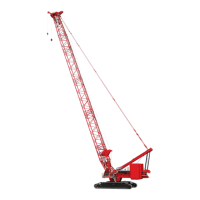Manitowoc Published 08-06-19, Control # 237-09_v1 3-35
MLC165-1 OPERATOR MANUAL OPERATING CONTROLS AND PROCEDURES
OPERATING IN WIND
Wind adversely affects lifting capacity and stability. The
result could be loss of control over the load and crane, even
if the load is within the crane’s capacity.
Do not raise the boom for the purpose of measuring the wind
speed with the crane’s anemometer.
Wind speed (to include wind gusts) shall be monitored by job
planners and supervisors.
The wind speed at the boom or jib point can be greater than
the wind speed at ground level. Also be aware that the larger
the sail area of the load, the greater the wind’s affect on the
load.
As a general rule, ratings and operating speeds must be
reduced when:
Wind causes load to swing forward past allowable
operating radius or sideways past either boom hinge
pin.
For wind conditions specific to this crane, see the Wind
Conditions Chart at the end of this section or, if applicable,
see the wind conditions in Capacity Charts provided with the
crane and attachment.
CRAWLER BLOCKING
To prevent the crane from tipping, some boom and jib
lengths require blocked crawlers. See the appropriate
Liftcrane Boom or Jib Capacity Chart for blocked crawler
requirements.
For crawler blocking dimensions and instructions, see the
Crawler Blocking topic in the Capacity Chart Information
Folio located in the Capacity Chart Manual supplied with the
crane.
OPERATING PROCEDURES
Preparing the Crane for Operation
WARNING
Tipping Crane Hazard
The judgment and experience of qualified operators, job
planners, and supervisors shall be used to compensate
for the affect of wind on the lifted load and the boom by
reducing ratings or operating speeds, or a combination of
both.
Failing to observe this precaution can cause the crane to
tip or the boom and/or jib to collapse. Death or serious
injury to personnel can result.
DANGER
Tipping Hazard!
Do not attempt to raise or lower the boom or the boom
and jib from or to ground level until the crawlers are
blocked, if required. Otherwise, the crane will tip.
WARNING
Read and Use the Capacity Charts
Do not attempt to operate the crane without first reading
and understanding the capacity charts located in the
Capacity Chart Manual supplied with the crane.
The crane must be rigged and operated according to the
instructions given in the capacity charts and rigging
guides.
Unless otherwise specified in the capacity charts, all
crane operations shall be performed with the crane level
to within 1% of grade in all directions—1 ft in 100 ft (0,3 m
in 30 m), otherwise the crane could tip.
Do not operate the crane—including raising the boom
from ground level—if the wind speed exceeds the limits
given in the Wind Conditions chart located at the end of
this section and in the Capacity Chart Manual.
Failing to comply with the requirements of the capacity
charts can result in tipping or structural failure of the boom
or luffing jib.
Equipment Failure Hazard
At low ambient temperatures, dynamic loads (impact and
shock) can affect the steels used in Manitowoc cranes
when operating in cold weather. Read and comply with
Cold Weather Operation on page 3-49
before operating
the crane.

